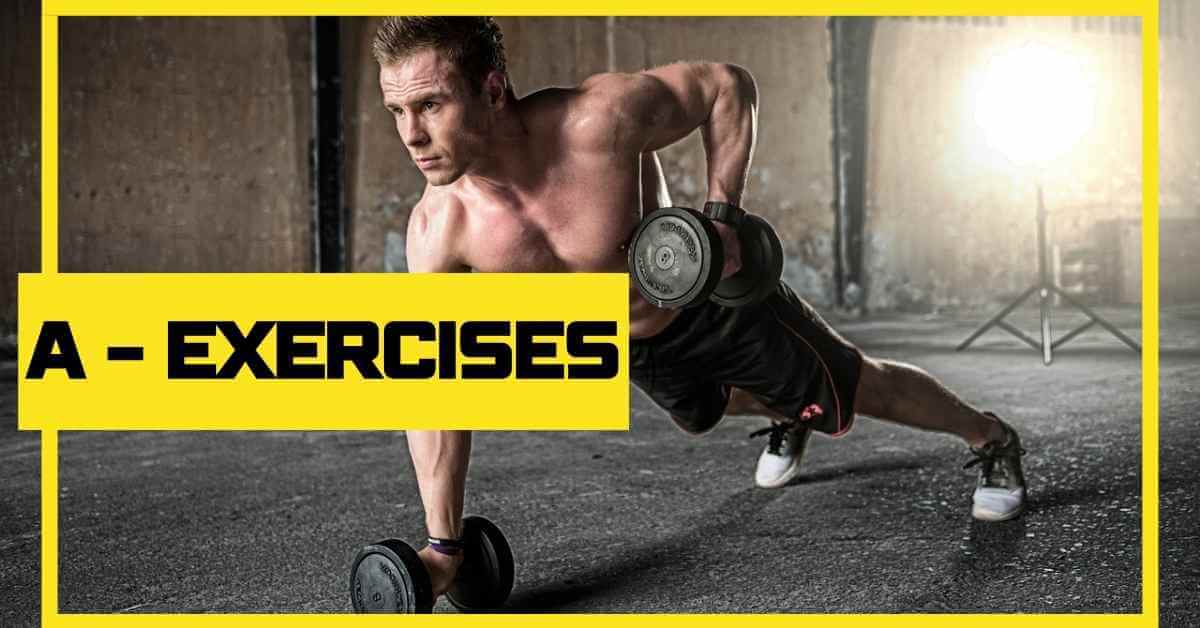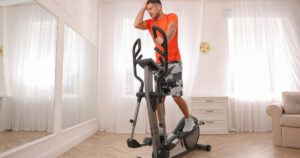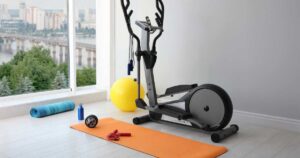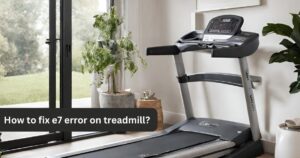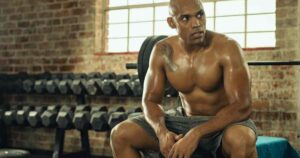List of 6 must-try Exercises that Start with the Letter A (How To Perform, common mistakes to avoid, tips, Intensity level, Muscles Worked, Average Calorie Burn)
Greetings, fitness lover! Are you tired of feeling sluggish and unmotivated? Do you find yourself constantly battling stress or struggling to maintain a healthy weight? Well, we have a simple solution that can transform your life: exercise! Yes, you heard it right.
In this amazing post, We’re going to present you with 6 must-try exercises that start with the letter A. These exercises are not just for fitness athletes; it is something that everyone should include in their daily routine.
So get ready to lace up those sneakers and discover 6 amazing exercises that start with the letter A.
6 Must-Try Exercises That Start With The Letter A
- Arm Pullover
- Air Squats
- Arm Circles
- Atomic Push-Ups
- Assisted Pull-Ups
- Agility Ladder Drills
Arm Pullover
The arm pullover exercise is a fantastic way to target multiple muscle groups, including the chest, back, shoulders, and arms. This exercise primarily focuses on strengthening your upper body while also engaging your core muscles for stability.
How To Perform:
- Lie flat on your back on a mat or bench, with your knees bent and feet firmly planted on the ground.
- Hold a dumbbell or kettlebell in both hands directly above your chest, arms extended and palms facing inward.
- Slowly lower the weight behind your head by bending at the elbows, keeping them slightly bent throughout the movement.
- Continue lowering until you feel a stretch in your chest and shoulders, but be careful not to let the weight touch the ground.
- Engage your core muscles and use them to bring the weight back up to the starting position, maintaining control throughout the entire range of motion.
- Repeat for the desired number of reps, focusing on maintaining proper form and breathing rhythmically throughout each repetition.
Common Mistakes to Avoid While Doing Arm Pullover:
- Using too much weight: One common mistake people make while performing the arm pullover exercise is using weights that are too heavy for them.
- This can put excessive strain on the shoulders and increase the risk of injury. It’s important to start with lighter weights and gradually increase the load as your strength improves.
- Overarching the back: Another mistake to avoid is arching your back excessively during this exercise. This not only takes away from targeting the intended muscles but also puts unnecessary stress on your spine. Keep your core engaged and maintain a neutral spine position throughout the movement.
- Rushing through the exercise: Many people tend to rush through their repetitions, sacrificing proper form in favor of speed.
- Remember that quality is more important than quantity when it comes to any exercise, including arm pullovers. Take your time, focus on engaging the targeted muscles, and perform each repetition with control.
- Neglecting proper breathing technique: Breathing plays a crucial role in any exercise routine, and arm pullovers are no exception.
- Avoid holding your breath or shallow breathing during this movement. Instead, inhale deeply before starting each repetition and exhale as you extend your arms overhead.
- Failing to stabilize the shoulder blades: Proper shoulder blade stabilization is essential for an effective arm pullover workout.
- Make sure to keep your shoulder blades down and back throughout the entire movement to maximize muscle activation in both your chest and upper back.
- Moving beyond a comfortable range of motion: Avoid pushing yourself beyond a comfortable range of motion during arm pullovers. If you feel any pain or discomfort in your shoulders or neck, stop immediately and reassess your form or consult with a fitness professional for guidance.
Tips to Maximize the Effectiveness of Arm Pullover:
- Focus on form: When performing the Arm Pullover exercise, it’s crucial to maintain proper form throughout. Keep your core engaged, shoulders relaxed, and back flat against the bench or mat.
- Start with lighter weights: If you’re new to this exercise, start with lighter weights to get a feel for the movement and build up your strength gradually. As you progress, you can increase the weight to challenge yourself further.
- Control the movement: Avoid swinging or jerking motions while performing the Arm Pullover. Instead, focus on controlled and smooth movements throughout each repetition. This will maximize muscle engagement and reduce the risk of injury.
- Breathe properly: Remember to inhale during the eccentric phase (lowering) of the exercise and exhale during the concentric phase (lifting). Proper breathing technique helps stabilize your core and provide optimal oxygen flow to working muscles.
Intensity level:
The intensity level of the Arm Pullover exercise can vary depending on several factors. It is considered a moderate to high-intensity exercise that targets multiple muscle groups, including the chest, shoulders, and back.
To increase the intensity of this exercise, you can use heavier weights or resistance bands. You can also perform more repetitions or decrease your rest time between sets. Remember to listen to your body and progress at a pace that feels challenging but manageable for you.
Muscle worked:
- Latissimus Dorsi (Lats): The main muscle targeted during the arm pullover exercise is the latissimus dorsi, commonly known as the lats. These muscles are located on the sides of your back and play a significant role in pulling movements.
- Pectoralis Major: The pectoralis major, or chest muscles, are also engaged when performing arm pullovers. This exercise targets both the upper and lower portions of the pecs, helping to develop overall chest strength and definition.
- Triceps Brachii: As you extend your arms overhead during an arm pullover, your triceps brachii muscles at the back of your upper arms come into action. They assist in stabilizing and controlling the movement.
- Rhomboids: The rhomboid muscles located between your shoulder blades are activated during arm pullovers to help retract and stabilize them.
- Deltoids: Your deltoid muscles, which form your shoulders’ rounded shape, also contribute to this exercise by assisting with shoulder extension and stabilization.
- Serratus Anterior: The serratus anterior muscles along the sides of your ribcage aid in scapular protraction as you perform arm pullovers.
Average Calorie Burn:
When it comes to burning calories, the Arm Pullover exercise can be a great addition to your workout routine.
This compound movement targets multiple muscle groups, helping you build strength and burn calories simultaneously. But how many calories can you expect to burn during an Arm Pullover session?
On average a person weighing around 150 pounds can expect to burn approximately 100 to 150 calories in a 30 minute session of Arm Pullovers.
SEE ALSO: 5 MUST-TRY EXERCISES THAT START WITH K
Air Squats
Air squats are a fundamental exercise that targets multiple muscle groups in the lower body. They are a simple yet effective movement that can be performed anywhere, making them an excellent addition to any workout routine.
How To Perform:
- Start by standing with your feet shoulder-width apart and toes pointing slightly outward.
- Keep your back straight and engage your core muscles.
- Lower your body down as if you are sitting on an imaginary chair, bending at the knees and hips simultaneously.
- Make sure to keep your weight in your heels and maintain a neutral spine throughout the movement.
- Continue lowering until your thighs are parallel to the ground or as low as you comfortably can go.
- Pause for a moment at the bottom of the squat before pushing through your heels to return to the starting position.
- Repeat for the desired number of repetitions.
Remember, it’s important to focus on proper form rather than speed or quantity when performing air squats. This will help prevent injury and ensure maximum effectiveness.
Common Mistakes to Avoid While Doing Air Squats:
- Poor Form: One of the most common mistakes people make when performing air squats is having poor form. This includes not maintaining a proper stance, failing to keep the knees in line with the toes, or rounding the back during the movement.
- To avoid these mistakes, it’s important to focus on maintaining a neutral spine and engaging your core throughout the exercise.
- Shallow Squats: Another mistake is only performing shallow squats where you don’t fully reach parallel or go deep enough into the squat position. This limits the effectiveness of the exercise and doesn’t engage all of your leg muscles properly.
- Remember to lower yourself down until your thighs are at least parallel to the ground for optimal results.
- Rushing Through Repetitions: Many people tend to rush through their air squats without focusing on each repetition and controlling their movements.
- It’s crucial to perform each squat with intention and control, ensuring that you’re engaging your muscles throughout both phases – lowering down and coming back up.
- Neglecting Breathing Technique: Proper breathing technique plays a significant role in any exercise, including air squats.
- Some Persons forget to breathe out as they lower themselves down or hold their breath during repetitions which can lead to decreased performance and potential dizziness or lightheadedness.
- Overloading Weight Too Soon: While air squats are bodyweight exercises that start with the letter a, some Persons may be tempted to add additional weight too soon before mastering proper form and technique first.
- It’s essential to establish a strong foundation before progressing onto weighted variations.
Tips to Maximize the Effectiveness of Air Squats:
- Control your descent: Avoid rushing through the downward phase of the squat. Instead, focus on controlling your descent and feeling the burn in your quads and glutes.
- This will not only maximize muscle engagement but also reduce the risk of injury.
- Keep your chest up: It’s crucial to maintain good posture during air squats by keeping your chest lifted and shoulders back. This helps engage the upper body muscles while preventing unnecessary strain on the lower back.
- Breathe properly: Remember to breathe throughout each rep, inhaling deeply as you descend and exhaling forcefully as you push up from the squat position.
- Gradually increase intensity: As you become more comfortable with air squats, challenge yourself by adding weights or trying variations like jump squats or pistol squats to further enhance strength gains.
Intensity level:
The intensity level of Air Squats can vary depending on various factors such as your fitness level, effort exerted, and speed at which you perform the exercise.
For beginners or those with limited mobility, air squats can be a great low-intensity exercise to start building strength in the lower body.
As you become more comfortable with the movement, you can gradually increase the intensity by squatting deeper, increasing your speed, or adding resistance.
To make air squats more challenging and increase the intensity you can incorporate variations such as jump squats or pistol squats.
Muscle worked:
- First and foremost, air squats primarily target your quadriceps, which are the large muscles at the front of your thighs. These muscles play a crucial role in knee extension and help you maintain proper form throughout the movement.
- In addition to working your quads, air squats also activate your hamstrings. These muscles are located at the back of your thighs and assist with hip extension as well as knee flexion.
- Furthermore, air squats engage the gluteal muscles or buttocks. Your glutes work hard during this exercise to extend your hips when returning to a standing position from the squatting position.
- Another important muscle group involved in air squats is the calves. As you push through your heels while performing this exercise, it activates these lower leg muscles.
- Although not directly targeted by air squats, they require stability from your core muscles. The abdominal muscles along with other smaller stabilizing muscles in the torso area are engaged to maintain balance and control during each squat repetition.
Average Calorie Burn:
The average calorie burn during a session of air squats can vary depending on several factors such as your weight, intensity level, and duration of the exercise.
Research suggests that you can expect to burn approximately 5-8 calories per minute when performing air squats.
To maximize calorie burn during air squats, it’s important to maintain proper form and perform them with controlled movements. The more muscles you engage and the faster your repetitions are performed (while maintaining proper technique), the higher your calorie consumption will be.
Arm Circles
Arm Circles is a simple yet effective exercise that targets the muscles in your shoulders, arms, and upper back. It involves making circular motions with your arms, either forward or backward. This exercise can be done using just your body weight or with the addition of light dumbbells for added resistance.
How To Perform:
- Stand with your feet shoulder-width apart and extend your arms out to the sides, parallel to the floor.
- Begin by making small circles with your arms, gradually increasing the size of the circles as you feel comfortable.
- Keep your core engaged and maintain a slight bend in your elbows throughout the exercise.
- Focus on using controlled movements and maintaining proper form.
- Continue circling your arms forward for a set number of repetitions or times, then switch directions and circle them backward.
- Remember to breathe deeply and relax your shoulders during the exercise.
Common Mistakes to Avoid While Doing Arm Circles:
- Incorrect Form: One common mistake people make while performing arm circles is using incorrect forms. It’s important to maintain proper posture and alignment throughout the exercise.
- Avoid slouching or rounding your shoulders, as this can put unnecessary strain on your neck and upper back.
- Overly Large Circles: Another mistake is making overly large circles with your arms. While it may seem like a bigger range of motion equals better results, in reality, it can lead to shoulder discomfort or injury.
- Keep your arm circles controlled and within a comfortable range of motion.
- Jerky Movements: Smoothness is key when performing arm circles. Avoid jerking or swinging your arms forcefully, as this can strain the muscles and joints involved. Instead, focus on maintaining a steady and controlled movement throughout the exercise.
- Neglecting Breathing: Many people forget to breathe properly during arm circles, which can hinder their effectiveness and potentially cause dizziness or lightheadedness.
- Remember to inhale deeply through your nose as you raise your arms, and exhale fully through your mouth as you lower them down.
- Lack of Variation: Arm circles are an excellent warm-up exercise, but they shouldn’t be the only upper body movement in your workout routine.
- It’s essential to include other exercises that start with the letter A that target different muscle groups for a well-rounded training session.
Tips to Maximize the Effectiveness of Arm Circles:
- Start Slowly: When performing arm circles, it’s important to start slowly and gradually increase your speed. This allows your muscles to warm up and prevents any strain or injury.
- Control Your Movements: Rather than swinging your arms haphazardly, try to control each movement during arm circles. Maintain a steady pace and make sure you’re fully extending your arms with each rotation.
- Vary the Direction: To work different muscle groups in your shoulders and upper back, vary the direction of your arm circles. Alternate between clockwise and counterclockwise rotations during each set.
- Include Resistance: To add intensity to your workout, consider using resistance bands or light weights while performing arm circles. This will challenge your muscles even more and help build strength over time.
- Don’t Forget to Breathe: It’s easy to get caught up in the movements, but don’t forget to breathe properly throughout the exercise. Inhale deeply as you raise your arms overhead and exhale as you bring them down.
Intensity level:
When it comes to intensity, arm circles fall on the lower end of the spectrum. This exercise is typically used as a warm-up or cool-down movement rather than a high-intensity workout.
The main purpose of arm circles is to increase the range of motion and loosen up the shoulder joints. It helps in improving flexibility and mobility in your upper body.
Since arm circles involve repetitive circular motions, they do not put excessive strain on the muscles or elevate the heart rate significantly. The intensity can be adjusted by varying the size and speed of the circles.
Muscle worked:
- First and foremost, arm circles primarily target the deltoids, which are the triangular muscles located at the top of your shoulders.
- As you perform this exercise, you’ll feel a deep burn in these muscles as they work hard to move your arms in circular motions.
- Additionally, arm circles also engage the trapezius muscles found along the back of your neck and upper spine. These muscles help stabilize and support your shoulder blades during movements like arm circles.
- Furthermore, don’t be surprised if you feel some activation in your biceps and triceps while performing this exercise. The continuous circular motion requires these arm muscles to contract and relax repeatedly.
- Although not directly targeted by arm circles, engaging all these upper body muscles indirectly benefits other areas such as the chest and core.
- By maintaining proper form throughout the exercise, you’ll naturally activate these muscle groups for added stability.
Average Calorie Burn:
Have you ever wondered how many calories you can burn by doing arm circles? While it may not be as intense as some other exercises that start with the letter A, arm circles still contribute to calorie burn.
Doing arm circles for about 10 minutes can help you burn approximately 30 to 50 calories. However, keep in mind that individual results may vary.
To maximize calorie burn during your arms circle workout, consider increasing the intensity or including them in a circuit-style routine with other cardio or strength exercises. This way you can elevate your heart rate and increase overall calorie consumption.
Atomic Push-Ups
Atomic Push-Ups are a challenging and dynamic exercise that targets multiple muscle groups in your upper body, core, and legs. This compound movement combines the traditional push-up with an explosive jump, making it a great way to build strength, power, and endurance.
How To Perform:
- Start in a high plank position with your hands shoulder-width apart and your body in a straight line from head to toe.
- Engage your core and lower yourself down into a push-up, bending your elbows until they reach 90 degrees.
- As you push back up, explosively jump both feet forward towards your hands, landing in a squat position.
- From the squat position, immediately explode upwards into a jump, extending your arms overhead.
- Land softly back into the squat position and then reverse the movement by jumping both feet back out to the plank position as you lower yourself down into another push-up.
- Repeat this sequence for the desired number of reps or time duration.
Common Mistakes to Avoid While Doing Atomic Push-Ups:
- Poor Core Stability: One common mistake is not maintaining a strong core during atomic push-ups. Your core muscles play a crucial role in stabilizing your body and preventing any sway or sagging during the exercise.
- Make sure to engage your abs, glutes, and lower back throughout the movement.
- Incorrect Hand Placement: Placing your hands too wide or too close together can affect your form and the effectiveness of the exercise.
- Aim for shoulder-width hand placement to ensure proper alignment of your wrists, elbows, and shoulders.
- Lack of Control: Avoid rushing through atomic push-ups without proper control over the movement.
- Focus on performing each rep with controlled descent and explosive power on the way up, rather than relying solely on momentum.
- Neglecting Full Range of Motion: Another mistake is not fully extending your arms at the top position or failing to reach a 90-degree angle at the bottom position.
- Maintain a full range of motion to effectively target all muscles involved.
- Hunching Shoulders: It’s important to keep your shoulders down and away from your ears throughout the entire exercise.
- Avoid hunching or shrugging them as this can lead to unnecessary strain on your neck and upper back.
SEE ALSO: Exercises that Start with the Letter C
Tips to Maximize the Effectiveness of Atomic Push-Ups:
- Start with Modified Versions: If you’re new to atomic push-ups or find them challenging, start with modified versions. You can perform knee push-ups or use an elevated surface like a bench or step to reduce the intensity.
- Gradually Increase Intensity: As you become more comfortable with atomic push-ups, gradually increase the intensity by lowering yourself closer to the ground and eventually attempting a full range of motion.
- Focus on Breathing: Don’t forget about your breath! Inhale as you lower yourself down and exhale as you push back up. This helps stabilize your core and enhances overall performance.
- Use Proper Hand Placement: Place your hands slightly wider than shoulder-width apart for optimal stability during atomic push-ups. This allows for better engagement of the chest, shoulders, triceps, and core muscles.
- Take Breaks if Needed: It’s important to listen to your body and take breaks when necessary during atomic push-up sessions. Pushing through exhaust may lead to poor form and an increased risk of injury.
Intensity level:
The intensity level of Atomic Push-Ups can vary depending on factors such as your fitness level, form, and the number of repetitions you perform.
Atomic Push-Ups are a challenging exercise that targets multiple muscle groups simultaneously, making them an effective full-body workout.
By combining elements of push-ups and plyometric movements, Atomic Push-Ups increase the intensity and engage muscles in both the upper and lower body.
To maximize the intensity of Atomic Push-Ups, focus on maintaining proper form throughout each repetition.
This means keeping your core engaged, back straight, and shoulders stable. Avoid rushing through the movement; instead, control each rep to fully engage all targeted muscles.
Muscle worked:
- Chest: The main muscle targeted during Atomic Push-Ups is the chest, specifically the pectoralis major and minor. As you lower your body down towards the ground, these muscles contract to push your body back up.
- Shoulders: Your shoulders also play a significant role in performing Atomic Push-Ups. The deltoid muscles, located at the top of your shoulders, are responsible for stabilizing and controlling the movement as you go through each rep.
- Triceps: To execute an Atomic Push-Up effectively, strong triceps are essential. These muscles are located on the back of your upper arms and assist in extending your elbows as you push yourself off the ground.
- Core: Maintaining a stable core is crucial throughout this exercise.
- The rectus abdominis (six-pack muscles) along with other core muscles like obliques and transverse abdominis work together to stabilize your spine during each repetition.
- Glutes and Hamstrings: As you perform an Atomic Push-Up, engaging both gluteal and hamstring muscles helps maintain proper alignment from head to toe while also providing stability through hip extension movements.
- Quadriceps: Even though not directly engaged in the movement itself, the quadriceps play a supportive role by keeping their legs straight throughout the exercise.
Average Calorie Burn:
When it comes to calorie burn, Atomic Push-Ups are a powerhouse exercise that can help you torch those extra calories. This intense full-body movement engages multiple muscle groups simultaneously, resulting in a higher calorie consumption.
A person weighing around 150 pounds can expect to burn approximately 10 to 15 calories per minute while performing Atomic Push-Ups.
Since this exercise involves explosive movements and combines both upper body strength and core stability, it increases your heart rate significantly.
The elevated heart rate leads to an increased metabolic rate which aids in burning more calories even after you finish your workout.
Assisted Pull-Ups
Assisted pull-ups are a variation of the traditional pull-up exercise that provides support and assistance to Persons who may not have enough strength to perform a full pull-up on their own. This exercise is particularly beneficial for beginners or those who are working towards building their upper body strength.
How To Perform:
- Find an assisted pull-up machine or use resistance bands. Set the assistance level according to your ability.
- Stand on the platform of the machine or loop the resistance band around a secure anchor above you.
- Grip the bar with your palms facing away from you (overhand grip) and hands slightly wider than shoulder-width apart.
- Hang with your arms fully extended, shoulders down, and engage your core muscles.
- Slowly bend your elbows and raise yourself towards the bar until your chin is above it or as close as possible while maintaining proper form.
- Lower yourself back down with control until your arms are fully extended again.
- Repeat for the desired number of repetitions according to your fitness level.
Common Mistakes to Avoid While Doing Assisted Pull-Ups:
- Using too much assistance: One common mistake is relying heavily on the assistance provided by the machine or resistance band.
- While it’s important to have some support, using too much can prevent you from building strength and progressing towards unassisted pull-ups. Gradually reduce the amount of assistance as you get stronger.
- Neglecting proper form: Another mistake is sacrificing form for quantity. It’s crucial to maintain proper posture throughout the exercise, with shoulders pulled back and core engaged.
- Avoid swinging your body or using momentum to complete the movement, as this reduces the effectiveness of the exercise and increases the risk of injury.
- Failing to engage target muscles: Many people make the error of not properly engaging their back muscles during assisted pull-ups.
- To maximize results, focus on squeezing your shoulder blades together and pulling yourself up using primarily your upper back muscles rather than relying solely on arm strength.
- Not controlling the descent: A common oversight is neglecting the controlled lowering (eccentric) phase of assisted pull-ups.
- The eccentric portion provides additional muscle activation and contributes to overall strength gains. Avoid dropping down quickly; instead, aim for a slow and controlled descent.
- Too narrow grip or wide grip: Incorrect hand positioning also leads to mistakes in assisted pull-ups.
- A narrow grip places more emphasis on the biceps while reducing involvement from other muscle groups.
Tips to Maximize the Effectiveness of Assisted Pull-Ups:
- Use appropriate assistance: When performing assisted pull-ups, it’s important to choose the right level of assistance. Start with a band or machine that provides enough support but still allows you to challenge your muscles.
- Maintain proper form: Focus on maintaining good posture throughout the exercise. Keep your core engaged, chest lifted, and shoulders pulled down and back. Avoid swinging or using momentum to complete the movement.
- Gradually decrease assistance: As you get stronger, gradually reduce the amount of assistance you rely on during assisted pull-ups. This will help build strength in your upper body and progress towards unassisted pull-ups.
- Include negatives: Slowly lower yourself down from the top position (eccentric phase) instead of pulling yourself up (concentric phase). Negatives can help build strength in the muscles needed for full pull-ups.
- Add variety: Don’t limit yourself to just one type of assisted pull-up equipment or grip variation. Explore different options like bands, machines, or TRX suspension trainers to target different muscle groups and improve overall strength.
- Stay consistent: Consistency is key when trying to improve any exercise technique, including assisted pull-ups. Aim for regular practice sessions focusing on improving form and increasing reps over time.
Intensity level:
The intensity level of assisted pull-ups can vary depending on the amount of assistance provided. This exercise is a great way to build upper body strength, particularly targeting the back, arms, and shoulders.
To increase the intensity and challenge yourself, gradually decrease the amount of assistance over time. As you become stronger, you will be able to do more reps with less support.
It’s important to note that even with assistance, assisted pull-ups still require significant effort from your muscles. They provide a great workout for beginners who may not yet have the strength to perform traditional pull-ups.
Assisted pull-ups offer an intermediate level of intensity that can be customized to suit individual fitness levels and goals. Remember to always listen to your body and progress at a pace that feels challenging but manageable for you.
Muscle worked:
- The main muscle group engaged during this exercise is the latissimus dorsi or lats. These are large muscles located in your back that give you that desired V-shape appearance.
- Assisted pull-ups also target the rhomboids and trapezius muscles in your upper back, helping to improve posture and stability.
- Moving on to the upper body, assisted pull-ups heavily activate your biceps brachii – those bulging muscles on the front of your upper arm.
- Additionally, they engage other key arm muscles such as the brachialis and brachioradialis.
- Not only do assisted pull-ups work wonders for your upper body strength but they also recruit stabilizer muscles throughout your core region.
- Your abs and obliques play a crucial role in maintaining proper form while performing this exercise.
- Assisted pull-ups primarily target major muscle groups like the lats (back), and biceps (arms), and engage stabilizing core muscles.
Average Calorie Burn:
The average calorie burn during assisted pull-ups can vary depending on various factors such as your body weight, intensity level, and duration of the workout.
You can expect to burn approximately 100 to 150 calories during a 15 minutes session of assisted pull-ups.
It’s important to note that this estimate is just an approximation and individual results may vary. Factors like muscle mass, gender, and overall fitness level also play a role in determining calorie consumption.
SEE ALSO: HOW LONG DOES IT TAKE TO WALK 6 MILES?
Agility Ladder Drills
Agility ladder drills are a type of exercise that involves using a ladder-shaped tool to perform various movements. These drills are designed to improve agility, speed, and coordination. They are commonly used by athletes in sports such as football, basketball, and soccer.
How To Perform:
- Start by laying out the agility ladder on a flat surface. Make sure it is secure and won’t move during your workout.
- Before starting any exercise, it’s important to warm up your muscles and joints. Perform some dynamic stretches or light cardio exercises to get your body ready for the drills.
- There are various types of agility ladder drills you can try, such as lateral hops, high knees, or in-and-out jumps. Pick one that suits your fitness level and goals.
- Proper technique is crucial when performing agility ladder drills. Keep your feet light and quick, focusing on quick movements in and out of the ladder squares.
- Begin at a slower pace to familiarize yourself with the movement patterns before increasing speed or intensity.
- Once you feel comfortable with basic ladder drills, challenge yourself by adding more complex footwork patterns or increasing speed.
- To see progress and improve agility, make sure to incorporate agility ladder drills into your regular workout routine consistently.
Common Mistakes to Avoid While Doing Agility Ladder Drills:
- Poor foot placement: One common mistake is placing your feet incorrectly on the ladder rungs. Make sure to fully extend your legs and place them inside each square or rung, avoiding any overlapping or skipping.
- Lack of coordination: Agility ladder drills require precise coordination between your upper body and lower body movements.
- Many people tend to focus only on their footwork, neglecting their arm movements. Remember to coordinate your arms and legs to maximize the effectiveness of the exercise.
- Over-emphasizing speed: While agility ladder drills are meant to improve speed and quickness, it’s important not to sacrifice proper form for speed alone.
- Focus on maintaining proper technique throughout each drill rather than rushing through them.
- Stiff movements: Another mistake is performing agility ladder drills with stiff movements instead of engaging the entire body in fluid motions.
- Ensure that you maintain a relaxed posture while executing each drill, allowing for smooth transitions between steps.
- Ignoring progressions: Beginners often skip progressions and jump straight into advanced agility ladder drills without mastering the basics first.
- It’s crucial to start with simpler exercises before progressing to more complex ones to build a solid foundation.
- Neglecting warm-ups and cool-downs: Proper warm-ups and cool-downs are essential for preventing injuries and maximizing performance during agility ladder drill sessions.
- Take time to properly warm your muscles before starting any intense workout routine, including agility ladder drills.
Tips to Maximize the Effectiveness of Agility Ladder Drills:
- Start Slow and Focus on Form: When beginning agility ladder drills, it’s important to start slow and focus on your form.
- This will help you develop proper technique and prevent injuries. As you become more comfortable, gradually increase your speed.
- Stay Light on Your Feet: Agility ladder drills require quick footwork, so it’s essential to stay light on your feet. Avoid heavy steps or stomping down on the ladder rungs. Instead, aim for a quick and nimble movement with each step.
- Maintain Proper Body Alignment: To maximize the effectiveness of agility ladder drills, maintain proper body alignment throughout the exercise.
- Keep your chest up, shoulders back, and core engaged. This will help improve balance and coordination.
- Use Your Arms: Don’t neglect your arms during agility ladder drills! Utilize them to enhance your overall coordination by swinging them in sync with each step you take through the ladder.
- Increase Complexity Gradually: As you become more proficient in basic agility ladder drills, challenge yourself by increasing complexity gradually.
- Add lateral movements or incorporate different patterns into your routine to keep pushing yourself further.
- Practice Regularly: Consistency is key when it comes to improving agility with ladder drills! Make sure to practice regularly to build muscle memory and enhance overall performance.
Intensity level:
Agility ladder drills are known for their intense and fast-paced nature, making them a great choice for those looking to amp up their workout routine.
The intensity level of agility ladder drills can vary depending on factors such as the speed at which you perform the exercises and the complexity of the movements involved.
When performed at a high speed with minimal rest between sets, agility ladder drills can be classified as high-intensity interval training (HIIT).
HIIT workouts are known for their ability to increase heart rate and burn calories in a short amount of time. This makes agility ladder drills an excellent choice for those looking to improve their cardiovascular fitness and shed some extra pounds.
To make your agility ladder drill sessions even more challenging, you can include variations such as lateral hops or plyometric jumps. These explosive movements increase the intensity level by adding an element of power and explosiveness to your workout.
Muscle worked:
- Lower Body Muscles: The main muscles targeted in agility ladder drills are those in the lower body.
- These include the quadriceps, hamstrings, glutes, and calf muscles. As you step quickly through the ladder, these muscles work together to generate power and propel you forward.
- Core Muscles: Your core plays a vital role in maintaining balance and stability during agility ladder drills.
- The abdominal muscles (rectus abdominis and obliques) as well as the lower back (erector spinae) help stabilize your torso while performing quick footwork movements.
- Hip Muscles: The hip flexors (iliopsoas), located at the front of your hips, play a significant role in lifting your legs high enough to clear each rung of the ladder efficiently.
- Upper Body Muscles: Although not directly involved in moving through the agility ladder itself, certain upper body muscles come into play for stability purposes.
- The shoulder girdle muscles like the deltoids and trapezius help maintain proper posture throughout each drill.
Average Calorie Burn:
Studies have shown that Persons can burn anywhere from 200 to 300 calories in just 30 minutes of intense agility ladder training.
The reason behind the calorie burning power of agility ladder drills lies in its ability to engage multiple muscle groups simultaneously. With each quick step and precise footwork required to navigate through the ladder, you’re not only working your leg muscles but also engaging your core, arms, and shoulders.
Furthermore, the fast-paced nature of agility ladder drills keeps your heart rate elevated throughout the entire session. This continuous movement combined with bursts of sprinting between sets increases calorie consumption even further.
FAQs
Will 100 Air Squats a day do anything?
Ah, the mighty air squat. It’s a classic exercise that targets multiple muscle groups and can be done anywhere, anytime. But will doing 100 air squats a day make a difference? Let’s find out!
It’s important to understand that consistency is key when it comes to any fitness routine. Doing 100 air squats every day will have an impact on your lower body strength and endurance over time.
However, the specific results you’ll see may vary depending on factors such as your current fitness level and overall exercise regimen.
One of the main benefits of air squats is their ability to strengthen your quadriceps, hamstrings, glutes, and calves. By performing this exercise regularly, you can expect improved leg muscle tone and increased power in activities like running or jumping.
Additionally, because air squats engage so many large muscle groups at once, they can also help boost your metabolism and burn calories. This means that incorporating them into your daily routine could contribute to weight loss or maintenance efforts.
In conclusion, while 100 air squats a day won’t magically transform your physique overnight, they are certainly a valuable addition to any fitness routine. So go ahead and give them a try – after all, what do you have to lose besides some excess fluff?
How many Atomic Push-Ups should I do a day?
When it comes to determining how many atomic push-ups to incorporate into your daily routine, it ultimately depends on your fitness level and goals. If you’re new to this exercise or have limited upper body strength, starting with 5-10 reps per day is a good place to begin.
As you build strength and endurance over time, gradually increase the number of reps. Aim for 3 sets of 10-15 repetitions as an intermediate goal. For advanced fitness enthusiasts or those seeking an additional challenge, pushing beyond this range can help further enhance muscular development.
Are Assisted Pull-Ups better than lat pulldowns?
Are assisted pull-ups better than lat pulldowns? This is a common question among fitness enthusiasts who are looking to build their upper body strength. While both exercises target the back muscles, they have some key differences.
Assisted pull-ups are a great option for beginners or individuals who may not yet have the strength to do full unassisted pull-ups. The assistance provided by a machine or resistance band allows you to gradually increase your strength and work towards doing unassisted pull-ups.
On the other hand, lat pulldowns are performed using a cable machine where you sit down and pull the bar towards your chest. This exercise also targets the same muscles as assisted pull-ups but allows for more control and variation in terms of weight selection.
So which one is better? It ultimately depends on your personal goals and fitness level. If you’re just starting out or working on building strength, assisted pull-ups can be an effective way to progress towards unassisted ones.
However, if you prefer more control over your workout intensity or want to focus on specific muscle groups, lat pulldowns can be a suitable alternative.
Both assisted pull-ups and lat pulldowns provide benefits for building upper body strength. Consider incorporating both exercises into your routine to achieve well-rounded results.
Wrapping Up
So, fitness fans! we have explored a range of exercises that start with the letter A. From arm pullovers to agility ladder drills, these exercises offer unique benefits and work for various muscle groups in your body.
There are plenty of options to choose from based on your fitness level and goals. Whether you’re looking to strengthen your arms, improve your agility, or increase overall body strength, these exercises can help you achieve those goals.
These exercises that start with the letter A not only provide a great way to stay active and fit but also target different muscle groups, allowing for a well-rounded workout.
Remember that consistency is key when it comes to any exercise routine. Start with proper warm-up and gradually increase intensity as you progress. It’s important to listen to your body and make modifications if needed.
Lastly, stay motivated, stay consistent, and enjoy the journey toward a healthier and stronger version of yourself. Keep challenging yourself with diverse workouts that begin with other letters of the alphabet; their links can be found below.
